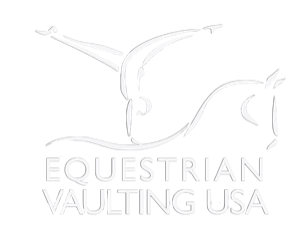Who We Are
There are more than 141 Equestrian Vaulting USA clubs and affiliates in states from Hawaii to Massachusetts and Alaska to Florida, and more than 1,400 members in the United States and Canada. EVUSA provides informational and educational vaulting materials, trains vaulting judges, provides procedures and standards for testing vaulters for medals at five different skill levels, establishes and maintains contacts in the international vaulting community, and facilitates EVUSA member participation in international exchanges and competitions.
A Visual Introduction to Vaulting

Safety in Sport
With its Three Points of Vaulting Safety that distinguish it from the riding disciplines, vaulting is the safest of all the equestrian activities. According to the United States Pony Club: “Safety is the first and most important application of vaulting.” In fact, the safety of vaulting served as the basis for EVUSA member participation in international exchanges and competitions.
Competitive vaulting was brought to the United States from Germany by Elizabeth Searle in the late 1960s. (Vaulting is considered a prerequisite for riding in Germany; the country has more than 100,000 vaulters, and over half the German riders holding competitive licenses today were vaulters in their early years.) She attended a vaulting display at the Olympic Games of 1956 in Stockholm and realized immediately that the United States Pony Club would benefit from the inclusion of vaulting in its program in terms of safety, opportunity, preparation for riding, and fun. When Mrs. Searle took a position at a riding school with a high accident rate, she insisted that all pupils earn a proficiency certificate in vaulting before being allowed to join a riding class. The accident rate dropped dramatically.
With its stringent reporting guidelines for member clubs, EVUSA has no reported concussions or deaths from vaulting (EVUSA Injury Summary Reports), and EVUSA vaulting injury summary reports reflect literally thousands of contact hours of vaulting practice for its members. With a lower incidence of injury than dressage, most vaulting injuries are comparable to those seen in gymnastics and are generally composed of sprains. And while it can be a thrilling spectator sport, vaulting has a lower injury rate than many other everyday activities. With its long and rich history (vaulting started as a young person’s activity in Northern Germany in 1930), the German statistics demonstrate the same high level of safety.
EVUSA would like to thank the Free Spirit Vaulters of Santa Fe, NM for creating the content for this entire Safety section.
Frequently Asked Questions

What is equestrian vaulting?
Vaulting is a unique and growing sport that combines dance and gymnastics on a moving horse. It's a wonderful way to develop coordination, balance, strength, and creativity while working in harmony with the horse.
What kinds of horses are used for vaulting?
Many different breeds and sizes of horses can be used for vaulting. The best vaulting horses are calm, strong, fit, kind, and have a consistent gait.
Is it like trick riding or circus riding?
No. Vaulting is always done in a very controlled environment—in a fully enclosed arena in a consistent, large circle, in soft footing, with the horse attached to a lunge line and controlled by a trainer (called a lunger). The horse, lunger and vaulter work as a team, with the lunger controlling the horse, the horse performing at a continuous gait (either walk, trot or canter, depending on the vaulter level). The vaulter performs a series of gymnastics and dance moves on the horse as it moves in its circle.
Is vaulting a team or individual sport?
Both! Vaulters may participate individually, in pairs, or as part of a team. In team competition, up to three members of the team are on the horse at once doing a variety of moves.
What if you don't own a horse?
No problem! Since vaulting is a team sport as well as an individual one, most clubs own and train the horses. All vaulters have the opportunity to be involved with the care of the horse, without the responsibility or expense of owning one.
Is vaulting safe?
Yes. Many factors contribute to the safety of our sport including the fact that the horse is controlled at all times by an experienced, trained longer. Vaulters are taught to condition their bodies with stretching and strengthening exercises and are also taught safe mounts and dismounts at all levels. Also, most exercises are learned on a stationary apparatus called a vaulting barrel before they are performed on the horse.

Who can vault?
Anyone! Vaulting programs are not for only competitive teams, but include recreational groups, Pony Clubs, 4-H Clubs and therapeutic vaulting programs.
Do the horses like to vault?
Our horses love to vault! Chosen specifically for their disposition, vaulting horses are also in excellent physical shape and are given lots of love and attention by their trainers and their vaulters.
At what age can you start vaulting?
One of the beauties of this terrific sport is that vaulters can be pre-schoolers or adults—and any age in between!
What are some of the skills that vaulting helps develop?
Vaulting helps develop balance, coordination, strength and creativity.
Does vaulting have a season?
Vaulting is a year-round sport, and an indoor or outdoor arena is used for working on the horse (depending on the weather).
Do I have to know how to ride a horse to begin vaulting?
No, you don't need to be able to ride to vault, but vaulting can greatly improve your riding skills.
Where can I vault?
Almost anywhere! You may connect with a local group or begin your own group. It's easy! If you're interested in starting a club or becoming a coach, contact EVUSA for instructional materials and the name of an established local group that can help you get started. If there is no one near you, EVUSA will help you find an experienced coach who can provide support via email, phone and clinics.
